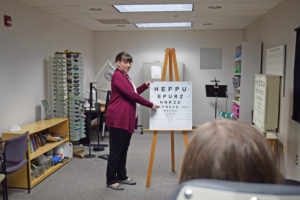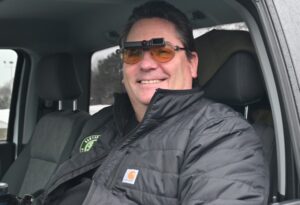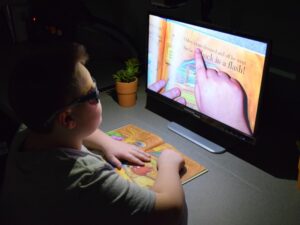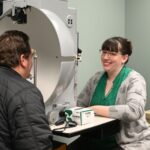Low vision occurs when a person has difficulty seeing and the vision is not correctable with glasses, contact lenses, surgery or medical treatment. Effects of low vision can be blur, loss of contrast, blind spots, light sensitivity, night blindness, or loss of peripheral vision.
In May of 2016, the clinic was renamed Judith A. Read Low Vision Services in memory of Judy Read, a longtime friend and former chairperson of the UDS Board of Directors. Mrs. Read’s dedication to the low vision clinic over the years has enhanced the lives of many individuals living with visual impairments in Northeast Ohio.
Low Vision Services Assessment

- Identification of the patient’s visual needs. This depends on age, interests, vocational goals and other factors.
- Education of the patient regarding their vision. It may include an explanation of the eye disease, how it affects function and why regular eyeglasses may not help. Sometimes teaching a person to find the “sweet spot” in their vision, how to scan, or where to position the material can help.
- Determine the best low vision aid for the task. Lighting, magnification, filters, adaptive technology or non-optical aids may be useful. In almost all cases, the patient needs more than one device to address their needs.
- Learn how to use the aid. It takes proper instruction and practice to learn to use low vision aids efficiently.
- Forms and brochures
-
Common causes of low vision
- Age-related macular degeneration
- Diabetic retinopathy
- Glaucoma
- Retinitis pigmentosa
- Optic nerve hypoplasia
- Albinism
- Eye injury
- Birth defects
-
Vision aids & assistive technology
- Utilizing magnifiers and telescopes
- Telescopic and microscopic glasses
- Prisms
- Lighting
- Specialty tinted lenses
- Video magnifiers
- Training in new techniques and equipment
-
Other beneficial aids and services
- Talking devices
- Activities of daily living
-
Meet our staff
Jocelyn Pettitt, O.D.

Dr. Pettitt has more than 15 years of direct patient care experience. She is a graduate of the Pennsylvania College of Optometry where was awarded the David J. Kerko Low Vision Award for excellence in the area of low vision. She completed her residency in Ocular Disease at the Louise Stokes VA Hospital in Cleveland.
Heidi Seymoure
 Heidi Seymoure is our office coordinator of nearly 17 years. She keeps the office running smoothly and makes sure that all of our video magnifiers (CCTVs) and technology are kept up to date. She’s well versed in all of our low vision aids as well. She also completes assessments and training for CCTVs and/or ADL (activities of daily living). Finally, she’s a wealth of knowledge about resources, funding, etc. so feel free to send your questions about Low Vision Services her way.
Heidi Seymoure is our office coordinator of nearly 17 years. She keeps the office running smoothly and makes sure that all of our video magnifiers (CCTVs) and technology are kept up to date. She’s well versed in all of our low vision aids as well. She also completes assessments and training for CCTVs and/or ADL (activities of daily living). Finally, she’s a wealth of knowledge about resources, funding, etc. so feel free to send your questions about Low Vision Services her way.Dr. Cheryl Reed
 Dr. Reed began her passion in the field of low vision while an optometry student completing low vision rotation at the Vision Center of Central Ohio. Serving Low Vision Services at UDS for over twenty years, Dr. Reed was integral in helping establish the services we provide today.
Dr. Reed began her passion in the field of low vision while an optometry student completing low vision rotation at the Vision Center of Central Ohio. Serving Low Vision Services at UDS for over twenty years, Dr. Reed was integral in helping establish the services we provide today.
What About Driving?
 Some individuals who have a visual impairment may be able to continue driving through the Northern Ohio Bioptic Driving Program. This program evaluates individuals, assesses and fits bioptic telescope glasses, and trains individuals to drive using telescopic glasses.
Some individuals who have a visual impairment may be able to continue driving through the Northern Ohio Bioptic Driving Program. This program evaluates individuals, assesses and fits bioptic telescope glasses, and trains individuals to drive using telescopic glasses.
Not everyone with a visual impairment is a candidate for the program. Individuals must meet specific vision requirements and also pass a challenging and comprehensive test administered by an Ohio driver’s license examiner.
Children

Children who are visually impaired need specialized services, adaptive equipment and accommodations in order to develop and achieve their fullest potential. Toddlers and children may benefit from and be eligible for the following services:
- Low Vision Assessment
- Low vision aids
- Assistive technology

 Heidi Seymoure is our office coordinator of nearly 17 years. She keeps the office running smoothly and makes sure that all of our video magnifiers (CCTVs) and technology are kept up to date. She’s well versed in all of our low vision aids as well. She also completes assessments and training for CCTVs and/or ADL (activities of daily living). Finally, she’s a wealth of knowledge about resources, funding, etc. so feel free to send your questions about Low Vision Services her way.
Heidi Seymoure is our office coordinator of nearly 17 years. She keeps the office running smoothly and makes sure that all of our video magnifiers (CCTVs) and technology are kept up to date. She’s well versed in all of our low vision aids as well. She also completes assessments and training for CCTVs and/or ADL (activities of daily living). Finally, she’s a wealth of knowledge about resources, funding, etc. so feel free to send your questions about Low Vision Services her way. Dr. Reed began her passion in the field of low vision while an optometry student completing low vision rotation at the Vision Center of Central Ohio. Serving Low Vision Services at UDS for over twenty years, Dr. Reed was integral in helping establish the services we provide today.
Dr. Reed began her passion in the field of low vision while an optometry student completing low vision rotation at the Vision Center of Central Ohio. Serving Low Vision Services at UDS for over twenty years, Dr. Reed was integral in helping establish the services we provide today.